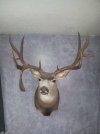Doodle
Well-Known Member
- Joined
- Sep 26, 2016
- Messages
- 64
You've gotten some pretty good advice this far. The only thing I will add is to buy clothing that fits well, and is designed for the conditions. This should be a consideration far greater than camo pattern. There's some top notch gear out there that's worthless if it's two sizes too big in the chest, or if the sleeves a 2 inches too short. Similarly, a jacket that's great for a tree stand will likely not be great for idaho mountain hunting - these are vastly different tasks with vastly different requirements.

